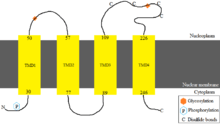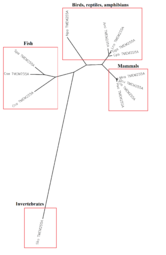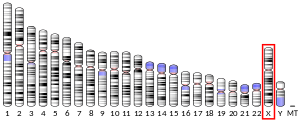Transmembrane protein 255A
Transmembrane protein 255A[5] is a protein that is encoded by the TMEM255A gene.[6] TMEM255A is often referred to as family with sequence similarity 70, member A (FAM70A).[7] The TMEM255A protein is transmembrane and is predicted to be located the nuclear envelope of eukaryote organisms.[8]
| TMEM255A | |||||||||||||||||||||||||
|---|---|---|---|---|---|---|---|---|---|---|---|---|---|---|---|---|---|---|---|---|---|---|---|---|---|
| Identifiers | |||||||||||||||||||||||||
| Aliases | TMEM255A, FAM70A, transmembrane protein 255A | ||||||||||||||||||||||||
| External IDs | MGI: 3045722 HomoloGene: 9927 GeneCards: TMEM255A | ||||||||||||||||||||||||
| |||||||||||||||||||||||||
| |||||||||||||||||||||||||
| Orthologs | |||||||||||||||||||||||||
| Species | Human | Mouse | |||||||||||||||||||||||
| Entrez | |||||||||||||||||||||||||
| Ensembl | |||||||||||||||||||||||||
| UniProt | |||||||||||||||||||||||||
| RefSeq (mRNA) | |||||||||||||||||||||||||
| RefSeq (protein) | |||||||||||||||||||||||||
| Location (UCSC) | Chr X: 120.26 – 120.31 Mb | Chr X: 38.2 – 38.25 Mb | |||||||||||||||||||||||
| PubMed search | [3] | [4] | |||||||||||||||||||||||
| Wikidata | |||||||||||||||||||||||||
| |||||||||||||||||||||||||
Gene
The TMEM25A gene (often referred to as Family with Sequence Similarity 70 Member A; FAM70A) is located on Xq24, spanning 60,555 base pairs.[10] TMEM255A is flanked by the genes ATPase Na+/K+ transporting family member beta 4 (ATP1B4) and NFKB activating protein pseudogene 1 (NKAPP1).[11]
mRNA
There are three variants of the transcript seen, where isoform 1 is the longest. The 5’- and 3’- UTRs of the mRNA spans 227 and 2207 base pairs, respectively, and are predicted to contain several stem-loops.[12] The mRNA is 3512 base pairs long and the gene consists of 9 exons.[13]

Protein
The longest protein encoded for is isoform 1, which spans 349 amino acids, and is predicted to have a molecular weight at 38 kDa and isoelectric point at pH 7.89.[15][16][17] Compared to the average vertebrate protein, TMEM255A is rich in aspartic acid, isoleucine, proline and tyrosine, and relatively poor in glutamic acid and lysine.[18] No charge clusters have been found in this protein.
The protein is predicted to be post-translationally modified by phosphorylation and glycosylation.[19] The protein is predicted to have four transmembrane domains in the nuclear membrane. The structure of the protein is predicted to be helical in the transmembrane domains.[20][21][22] Disulfide bonds are predicted to be found in the region in between transmembrane domains 3 and 4, which indicates that this particular region is located in the nucleoplasm.[23][24][25][26]
| Isoform | Accession number | Description | |
|---|---|---|---|
| 1 | NP_060408.3 | The longest transcript and isoform | |
| 2 | NP_001098014.1 | Shorter protein product than isoform 1, lacks one in-frame alternative midsection exon | |
| 3 | NP_001098015.1 | Lacks three in-frame exons. Shorter than isoform 1 and 2. |
Expression
TMEM255A is predicted to be most abundantly expressed in nerve, brain, testis, ovary, thymus and kidney. The protein is expressed in a variety of tissues, but at relatively moderate levels.[27][28][29]
Regulation of expression
Both the 5' and 3' Untranslated Regions (UTRs) are predicted to consist of several stem-loops.[30] The 3' UTR also contain a conserved miRNA target site (amino acids 22-29).[31] Phosphorylation and glycosylation sites have also been predicted in TMEM255A.[32][33]
Interacting proteins
Affinity Capture MS experimentally predicts that TMEM255A interacts with ten different proteins; Ankyrin repeat domain 13D (ANKRD13D), Collagen beta (1-O) galactosyltransferase 2 (COLGALT2), Grancalcin (GCA), Itchy E3 ubiquitin protein ligase (ITCH), Potassium channel tetramerization domain containing 2 (KCTD2), Neural precursor cell expressed developmentally down-regulated 4 (NEDD4), SEC24 family member B (SEC24D), Ubiquitin associated and SH3 domain containing B (UBASH3D), WW domain containing E3 ubiquitin protein ligase 1 and 2 (WWP1, WWP2) - most of these are included in ubiquitination processes, transcription regulation and protein degradation.[34]
Clinical significance
TMEM255A is predicted to be highly expressed in peroxisome proliferator-activated receptor γ coactivator 1α-upregulated glioblastoma multiforme cells (specific gene function not yet fully established).[35] Ongoing research is investigating the possibility of TMEM255A to be used in personalized immunotherapy.[36]
Homology

There is one known paralog for TMEM255A, called TMEM255B, which is found on chromosome 13 (position 13q34).[37] TMEM255A is only found in the kingdom of animalia, and its most distant homolog is found in invertebrata (i.e. Saccoglossus kowalenskii).
| Species | NCBI Accession # | Divergence (MYA) | Sequence Length (aa) | Sequence ID (%) | Sequence Similarity (%) |
|---|---|---|---|---|---|
| Homo sapiens (Human) | NP_060408.3 | - | 349 | 100 | 100 |
| Elephantulus edwardii (Cape Elephant Shrew) | XP_006893850.1 | 105 | 351 | 97 | 98 |
| Gallus gallus (Chicken) | XP_015134112.1 | 312 | 323 | 79 | 84 |
| Chrysemys picta bellii (Painted turtle) | XP_008167250.1 | 312 | 323 | 79 | 84 |
| Nanorana parkeri (High Himalaya frog) | XP_018415588.1 | 352 | 327 | 69 | 77 |
| Cyprinus carpio (Common carp) | XP_018971120.1 | 435 | 342 | 58 | 67 |
| Saccoglossus kowalevskii (Acorn worm) | XP_006819139.1 | 684 | 351 | 23 | 45 |
References
- GRCh38: Ensembl release 89: ENSG00000125355 - Ensembl, May 2017
- GRCm38: Ensembl release 89: ENSMUSG00000036502 - Ensembl, May 2017
- "Human PubMed Reference:". National Center for Biotechnology Information, U.S. National Library of Medicine.
- "Mouse PubMed Reference:". National Center for Biotechnology Information, U.S. National Library of Medicine.
- "Homo sapiens transmembrane protein 255A (TMEM255A), transcript variant - Nucleotide - NCBI". www.ncbi.nlm.nih.gov. 2018-06-24.
- NCBI, National Center for Biotechnology Information. "TMEM255A Transmembrane Protein 255A [Homo sapiens]". NCBI (National Center for Biotechnology Information).
- Database, GeneCards Human Gene. "TMEM255A Gene - GeneCards | T255A Protein | T255A Antibody". www.genecards.org. Archived from the original on 2013-08-23.
- "Search: TMEM255A - The Human Protein Atlas". www.proteinatlas.org. Retrieved 2017-04-26.
- Image: GeneCards, 2017
- "TMEM255A". www.genecards.org. April 25, 2017. Archived from the original on 2013-08-23.
- "Gene neighbors for Gene (Select 55026) - Gene - NCBI". www.ncbi.nlm.nih.gov. Retrieved 2017-04-26.
- "The Mfold Web Server". unafold.rna.albany.edu. Retrieved 2017-04-25.
- National Center for Biotechnology Information, NCBI. "TMEM255A transmembrane protein 255A [Homo sapiens (human)] - Gene - NCBI". www.ncbi.nlm.nih.gov. Retrieved 2017-04-26.
- Image: Kristin H. Aaen, 2017.
- National Center for Biotechnology Information, NCBI Gene (2017-04-02). "Transmembrane Domain 255A, Homo sapiens". NCBI Gene.
- Subramaniam, S. (1998). "The Biology Workbench: a seamless database and analysis environment for the biologist". Proteins. 2: 1–2. doi:10.1002/(SICI)1097-0134(19980701)32:1<1::AID-PROT1>3.0.CO;2-Q.
- Toldo, Luca (April 25, 2017). "Gateway to Isoelectric Point Service". Archived from the original on 2008-10-26.
- Dyer, K. F. (1971). "The quiet revolution: A new synthesis of biological knowledge". Journal of Biological Education. 5: 15–24. doi:10.1080/00219266.1971.9653663.
- Blom, N. (Summer 2002). "Prediction of post-translational glycosylation and phosphorylation of proteins from the amino acid sequence". Proteomics. 6: 1633–49.
- Yang, J. (2015). "The I-TASSER Suite: Protein structure and function prediction". Nature Methods. 12 (1): 7–8. doi:10.1038/nmeth.3213. PMC 4428668. PMID 25549265.
- Roy, A. (2010). "I-TASSER: a unified platform for automated protein structure and function prediction". Nature Protocols. 5 (4): 725–738. doi:10.1038/nprot.2010.5. PMC 2849174. PMID 20360767.
- Zhang, Y. (2008). "I-TASSER server for protein 3D structure prediction". BMC Bioinformatics. 9: 40. doi:10.1186/1471-2105-9-40. PMC 2245901. PMID 18215316.
- Ferre & Clote (2006). "DiANNA 1.1: an extension of the DiANNA web server for ternary cysteine classification". Nucleic Acids Res. - Web Servers. 34 (Web Server issue): W182-5. doi:10.1093/nar/gkl189. PMC 1538812. PMID 16844987.
- Ferre & Clote (Summer 2005). "DiANNA: a web server for disulfide connectivity prediction". Nucleic Acids Res. 33(Web Server Issue) (Web Server issue): W230–2. doi:10.1093/nar/gki412. PMC 1160173. PMID 15980459.
- Ferre & Clote (Summer 2005). "Disulfide connectivity prediction using secondary structure information and diresidue frequencies". Bioinformatics. 21 (10): 2336–46. doi:10.1093/bioinformatics/bti328. PMID 15741247.
- Go; et al. (2010). "Redox control systems in the nucleus: mechanisms and functions". Antioxidants & Redox Signaling. 13 (4): 489–509. doi:10.1089/ars.2009.3021. PMC 2935340. PMID 20210649.
- Input: TMEM255A. "EST Profile: Transmembrane Protein Domain 255A". NCBI UniGene. Retrieved April 2, 2017.
- National Cancer Institute, Cancer Genome Anatomy Project. "Transmembrane protein 255A". National Cancer Institute. National Cancer Institute. Retrieved 19 February 2017.
- BioGPS, BioGPS. "TMEM255A". BioGPS. BioGPS. Retrieved 19 February 2017.
- "SUNY Albany Research IT Group". mFold. 2017-04-02.
- Argawal; et al. (2017-04-17). "TargetScan Human: Prediction of miRNA Targets". TargetScan.
- Gupta & Brunak (2002). "Prediction of glycosylation across the human proteome and the correlation to protein function". Pacific Symposium on Biocomputing. 322: 310–22. PMID 11928486.
- Blom; et al. (2004-06-04). "Prediction of post-translational glycosylation and phosphorylation of proteins from the amino acid sequence". Proteomics. 4 (6): 1633–49. doi:10.1002/pmic.200300771. PMID 15174133.
- Chatr-Aryamontri; et al. (2016-12-14). "The BioGRID interaction database: 2017 update". Nucleic Acids Research. 45 (D1): D369–D379. doi:10.1093/nar/gkw1102. PMC 5210573. PMID 27980099.
- Cho; et al. (2017-01-13). "Expression of PGC1α in glioblastoma multiforme patients". Oncology Letters. 13 (6): 4055–76. doi:10.3892/ol.2017.5972. PMC 5453058. PMID 28599408.
- Weinschenk; et al. (2014). "Personalized immunotherapy against several neuronal and brain tumors". U.S. Patent Application No. 14/531: 472.
- Human Gene Database, GeneCards. "TMEM255B Gene". Weizman Institute of Science. GeneCards. Retrieved 19 February 2017.



